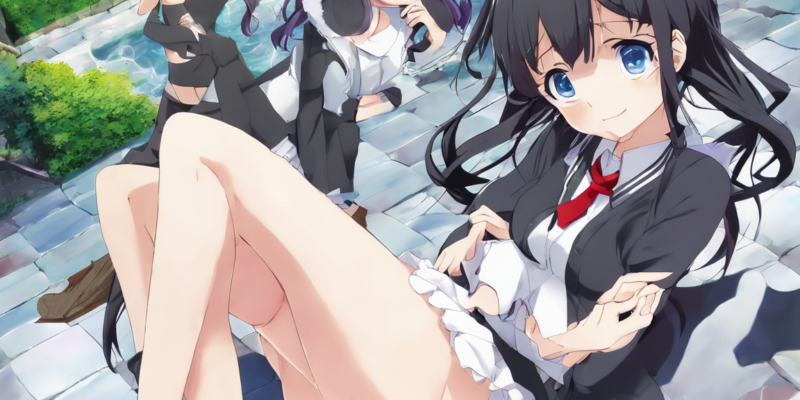Introduction
In recent years, Japanese pop culture has gained immense popularity worldwide, and one subculture that has captivated many is the world of “Gal”. Gals are known for their distinctive fashion sense, outgoing personalities, and their unique slang. Originating in the early 90s, Gal culture has evolved over the years but continues to be a significant part of Japanese youth culture today. Whether you are an avid fan of anime and manga or simply curious about different subcultures around the world, this guide will provide you with a comprehensive overview of Hajimete no Gal, a popular manga and anime series that explores the world of Gals.
What is “Hajimete no Gal”?
Hajimete no Gal, also known as “My First Girlfriend is a Gal”, is a Japanese manga series written and illustrated by Meguru Ueno. The manga was serialized in Kadokawa’s Monthly Shōnen Ace magazine from November 2015 to December 2017. It was later adapted into an anime television series that aired from July to September 2017.
The story follows the protagonist, Junichi Hashiba, a typical high school student who decides to confess his love to a “gal” named Yukana Yame. Gals are known for their fashionable attire, dyed hair, and outgoing personalities. Despite Yukana’s initial rejection, she agrees to be Junichi’s girlfriend, leading to a series of comedic and romantic misadventures.
Exploring Gal Culture
Gals first emerged in the 1970s and gained popularity in the 1990s. The term “Gal” is derived from the English word “gal” or “girl” and is used to describe young Japanese women who prioritize fashion, socializing, and having fun. The Gal subculture is characterized by its distinct fashion style, which includes blonde or bleached hair, tanned skin, heavy makeup, and flashy accessories.
One of the key components of Gal culture is “gyaru-moji”, a form of texting slang that Gals use to communicate with each other. This unique language consists of abbreviations, emoticons, and phonetic spellings, reflecting the group’s playful and carefree attitude.
In addition to their fashion sense, Gals are known for their outgoing personalities and love of socializing. They often frequent trendy shopping districts, cafes, and nightclubs, where they can connect with their peers and showcase their style.
Key Themes in “Hajimete no Gal”
Hajimete no Gal explores several themes that are central to Gal culture, including:
-
Love and Relationships: The series delves into the dynamics of teenage romance and the challenges that come with confessing one’s feelings to a crush.
-
Self-Discovery: Through his relationship with Yukana, Junichi navigates the complexities of love and learns more about himself in the process.
-
Friendship: The manga and anime highlight the importance of friendship and camaraderie among peers, showcasing how supportive relationships can positively impact one’s life.
-
Body Image: Gals often face societal judgment due to their unconventional fashion choices and tanned skin. The series addresses issues of self-acceptance and embracing one’s uniqueness.
Gal Fashion Trends
Gal fashion is a significant aspect of Hajimete no Gal and the wider Gal subculture. Some popular fashion trends among Gals include:
-
Kogal: A variation of the Gal style that originated in the 1990s, characterized by school uniforms worn with loose socks, mini skirts, and platform shoes.
-
Gyaru: A more mature and glamorous take on the Gal look, featuring stylish dresses, high heels, and elaborate hairstyles.
-
Manba: A subgenre of Gal fashion known for its extreme tanning, colorful makeup, and exaggerated hair accessories.
-
Onee Gal: A refined and elegant style that combines traditional Japanese elements with modern fashion trends.
Impact of “Hajimete no Gal”
Hajimete no Gal has garnered a dedicated fan following both in Japan and internationally. The series has been praised for its humor, relatable characters, and engaging storyline. By exploring the world of Gals through the lens of Junichi and Yukana’s relationship, the series offers insight into the complexities of teenage romance and the importance of self-acceptance.
The success of Hajimete no Gal has also sparked interest in Gal culture among anime and manga enthusiasts, leading to a greater appreciation for this unique subculture. Through its vibrant visuals, lighthearted humor, and heartfelt moments, the series has resonated with audiences of all ages.
Frequently Asked Questions (FAQs)
-
What is the origin of the Gal subculture?
The Gal subculture originated in the 1970s and gained prominence in the 1990s, with Gals known for their fashionable attire and outgoing personalities. -
What are some key characteristics of Gal fashion?
Gal fashion includes dyed or bleached hair, tanned skin, heavy makeup, flashy accessories, and stylish clothing choices. -
What is “gyaru-moji” in Gal culture?
Gyaru-moji refers to the texting slang used by Gals, which consists of abbreviations, emoticons, and phonetic spellings. -
What themes are explored in “Hajimete no Gal”?
The series delves into themes of love and relationships, self-discovery, friendship, and body image. -
How has “Hajimete no Gal” impacted popular culture?
The series has garnered a dedicated fan following and sparked interest in Gal culture among anime and manga enthusiasts worldwide.
In conclusion, Hajimete no Gal offers a captivating glimpse into the world of Gals and the vibrant subculture they inhabit. By exploring themes of love, friendship, and self-acceptance, the series resonates with audiences seeking lighthearted humor and heartfelt storytelling. Whether you are a seasoned fan of Japanese pop culture or a newcomer curious about different subcultures, Hajimete no Gal is sure to entertain and enlighten with its charming portrayal of teenage romance and the power of embracing one’s true self.

